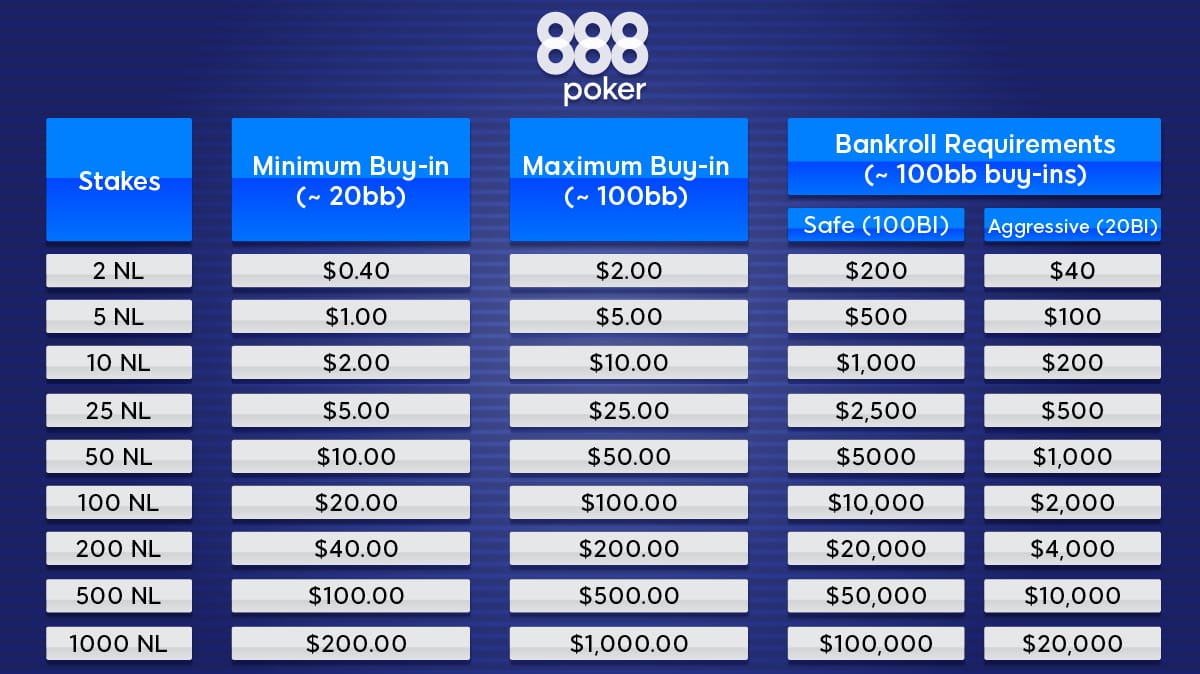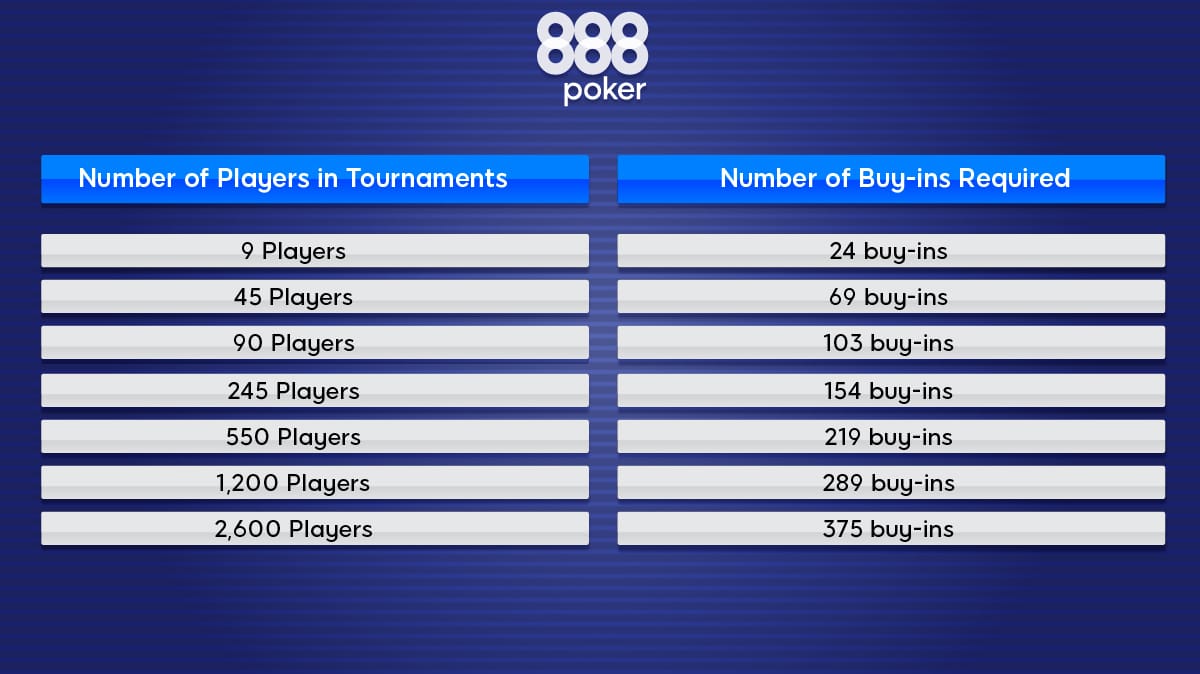Poker Bankroll Management (BRM) is one of the key pillars of being a successful poker player. It involves setting aside money you have designated for playing poker.
Poker has a high degrees of variance. So, knowing and following proper BRM is imperative.
This process promotes a healthy bankroll as you strive to improve your game and move up stakes.
There are a couple of different philosophies on proper bankroll management. The truth is that there is no one-size-fits-all solution.
Some players advocate playing a more aggressive approach. This method entails keeping a smaller number of required buy-ins. Then you would and takeshots at the next higher stake as soon as possible.
Others advocate exercising ultimate caution to minimise the potential to ever go broke.
In this article, we will cover the ins and outs of proper Bankroll Management–
Understanding Bankroll Buy-In Management Charts
There should be a hybrid of both theories. They can be utilized at different times as one grows their bankroll (i.e. for the first time).
Part of the reason for this ties into something that Jonathan Little says -
Your BRM guidelines should be dependent on your win rate for the game that you’re playing.
Take a look at the following chart:
NOTE: 3% chance of going broke using the guidelines outlined below:
 Bankroll Management guidelines chart
Bankroll Management guidelines chart
Typically, there is a more significant number of bad players at lower stakes games. As such, a solid reg will usually achieve a better bb/100 winrate at lower stakes (maybe 20bb/100 at 2NL).
This rate is greater when compared to medium and higher stakes (such as 3bb/100 at 200NL).
Let’s relate this info to the chart above. It becomes evident that a solid winning player will often require less strict BRM guidelines for lower stakes games.
At higher stakes games they need more because of their corresponding bb/100 win rates.
Reassessing Bankroll Management in Charts
Of course, a win rate can often take from 25,000 to 100,000 hands (minimum) to get an accurate determination/result. As you progress through this sample size, it’s crucial always to assess and re-assess this figure of yours.
Then you can relate it to how many buy-ins you should have to, comfortably, stay at the stake you’re playing.
As an example, a poker hobbyist, who ran hot for three sessions at $1/$2 live, boasted -
“Thanks to <insert some poker training course here>, I now have a win rate of $100/hr at 200NL after three sessions!”
Well, the truth isthis win rate might be valid for three sessions worth of poker. But it’s going to be almost impossible to maintain this rate over a 25k to 100k hand sample size. (Even the world’s best players wouldn’t be able to achieve win rates like that over enough hands.)
There are appropriate times when you may want to implore either safe or aggressive BRM.
Here is a chart outlining the minimum money requirements (in dollars) a particular stake:
 Minimum bankroll money requirements (in dollars)
Minimum bankroll money requirements (in dollars)Shot Taking: Moving Up Stakes
Practising “shot taking” is an essential part of moving up stakes. Most stakes are at least double the stake level immediately below. BRM guidelines dictate you should have 100 buy-ins for your stake
So, you’d need to have 200 to 250 buy-ins of your current stake to start playing the next one.
This situation would entail an extremely long grind at each stake. It is not at all practical from a time standpoint - especially if you’re already a winning player.
Players usually practise “shot taking” when moving up the ladder of stakes. They’ll often not have the recommended number of buy-ins when attempting to move up in stakes.
This fact might mean having as little as $9,000 from live $1/$2 profits before taking a shot at $2/$5 (18 buy-ins).
In this example, you could take three buy-in shots at 500NL before you’d have to move back down.
Note that the above example uses a 15 x buy-in minimum for shot-taking. (This rate is a standard, aggressive recommendation).
The lowest buy-ins one should EVER shot take with under any circumstance would be 11. (This number would leave one buy-in as a buffer. But you should never dip below 10 full buy-ins.)
Shot Taking: A Psychological Perspective
Some poker playerstake shots, purely based on psychological factors.
Let’s say that you’re hovering around a $6,000 roll. You usually, play $1/$2 live and want to take a shot at $2/$5 soon.
You put in a session at 200NL and build up a $700 stack ($500 profit) within a few hours.
Psychologically, this is a great time to take a shot at 500NL. If you lose your buy-in, you’ll still walk away at the end of the day even.
Players may also want to have 1.5 to 3 buy-ins set aside for their shot taking. If they lose a bit of their stack, they can still play a 100bb game without being a short stack.
How Much Do You Need To Go Pro?
 How to grow your bankroll successfully
How to grow your bankroll successfully
You can undoubtedly make a living grinding micro or low stakes games. But your corresponding win rate would require extremely long hours. (This rate also depends on where you live and what your typical annual expenses.)
As such, a recommended goal is to make it to 500NL in live poker rooms.
At that level, you should be able to –
- Pay your bills live
- Live comfortably
- Prove yourself to be a winning player
For online pros, it could be as low as 100NL. (Being able to play more hands per hour and multi-table will help compensate for a lower bb/100 winrate.)
Once you go 100% pro, it’s imperative that you nit-up your Bankroll Management (BRM). There is no side job to support you if things take a turn for the worse in poker.
So, you must protect your assets. Play a safer BRM than if you had other guaranteed income streams in the mix.
The recommended bankroll you’d need to go pro in a live setting is –
- $50,000 (100 buy-ins @ 500NL)
- PLUS 6-months of living expenses
In the above scenario, you should have between $60k and $65k before “going pro.”
BRM: Tournament Bankroll Requirements
Up until now, we’ve talked about the BRM needed for cash games?
What if you’re a tournament player, though?
Often, players will use an AVERAGE BUY-IN (ABI) rule to calculate which games they should play. For example, say their BRM requires 100 buy-ins.
With a $10,000 bankroll, they can only play $215 tournaments if they mix some lower buy-in, as well.
Tournaments carry unique BRM guidelines, as well.
The variance you will experience will much depend on factors such as:
- How many players there are in the tournament (how big the tournament field is).
- What your ROI is for such tournaments (over a decent sample size).
- How high the rake is? (Many live, small-buy-in “daily tournaments are not beatable over the long-term. The rake is too high relative to the prize pool. When just starting out, strive to find tournaments that have less than 13% rake.)
- The structure of the tournament: turbos and hyper-turbos will carry more variance. With the faster blind levels, you’ll be all-in more often and sooner.
Here is a baseline chart referencing the appropriate BRM for playing various tournaments sizes:
*30% ROI is assumed

Appropriate BRM for playing tournaments of various field sizes
When you dip about 20% below the required bankroll, it is wise to start lowering your average buy-in (ABI)
Try mixing in smaller games where you have a more significant win rate.
In Conclusion – Poker Bankroll Management
As you can see, there are many aspects to keeping a healthy bankroll and moving up stakes.
Here are FIVE key takeaways -
- Always keep in mind what your win rate is in the games you play. Be sure to be flexible with your BRM and adjust accordingly.
- Never hesitate to move down stakes, if necessary.
- Downswings are a normal part of the game. But they can cause substantial psychological effects, causing you play off you game.
- Being properly rolled should never be a worry when you’re at the table. Ifyou’re playing higher than you should, you won’t be able to play you’re A-game.
- If the dollar amount at the table seems too big, then you’re playing at too high a stake.
Keep these tips in mind as you build up your roll, and good luck at the felts!


